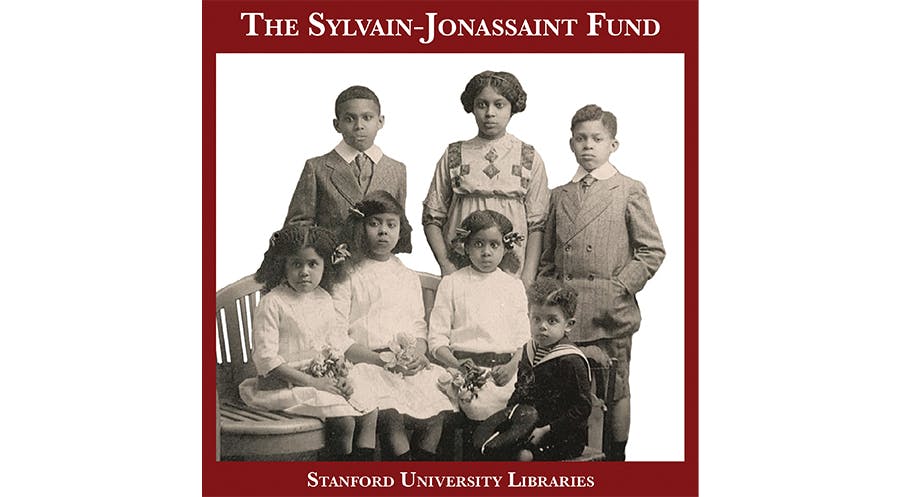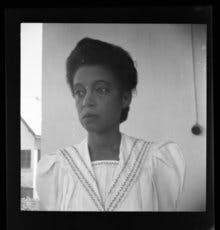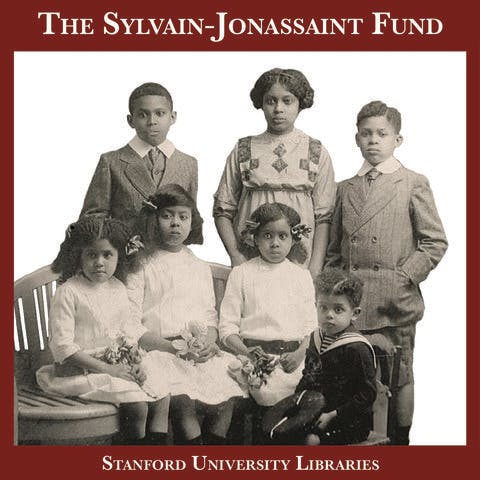Donor Spotlight: The Sylvain-Jonassaint Fund


Jean Jonassaint, Professor of French and Francophone Studies at Syracuse University and co-founder and co-editor of HDNdigest, a multilingual cybermedia, has established an endowment at Stanford Libraries in honor of anthropologist Suzanne Comhaire-Sylvain and for the advancement of Haitian Studies in Haiti and abroad. In this conversation, Professor Jonassaint discusses the origins of The Sylvain-Jonassaint Fund.
The papers and photographs of Suzanne Comhaire-Sylvain (1898-1975), acknowledged as Haiti’s first Black female anthropologist and best known for her work with the Creole languages, were acquired by Stanford Libraries in 2011. The Sylvain-Jonassaint Fund will seek to acquire unpublished materials complementing this collection, such as those pertaining to Comhaire-Sylvain’s immediate or extended family and to the cohorts of Haitian intellectual and cultural personalities with whom they were associated. The first acquisition using the Sylvain-Jonassaint Fund was a recent addendum to the Suzanne Comhaire-Sylvain papers.
How did Suzanne Comhaire-Sylvain (SCS) inspire your creation of the Sylvain-Jonassaint Fund?

Suzanne Comhaire-Sylvain’s exemplary life as scholar, educator and militant should be an inspiration for everyone… especially for a Haitian who shares an ancestor with her.
Indeed, her father and my maternal grandfather are cousins, grandsons of Gabriel Aristide Sylvain, who was of American origin according to my late mother, Yvette Sylvain. Her uncle Benito, one of the organizers of the First Pan-African Conference of 1900 in London, was born in Port-de-Paix, my hometown and the stronghold of the Sylvains and the Jonassaints. Moreover, we attended the same school of the Brothers of Christian Instruction (Frères de l’Instruction Chrétienne), and I spent my childhood in the shadow of the street that bears his name in Port-de-Paix.
Certainly, the scope of SCS’s archive is impressive. We must thank her late husband, the Belgium anthropologist Jean Comhaire; her son Jean Félix Comhaire Sylvain; and more than others, Professor Kathleen Gyssels, who safeguarded the materials until their acquisition by Stanford.

For me, their commitment to SCS’s legacy was a wake-call to our fellow Haitians on the importance of maintaining archives. As a Haitian and a scholar, I had to respond to this urgent call. So, I felt the need to create this endowment to contribute to enhancing this collection of documents (manuscripts, books, letters, audiotapes, personal papers, and so on) related to SCS’s work, and beyond, to all the Sylvain family (her mother, Eugénie Malbranche, her father Georges, her uncle Benito, her siblings Normil, Madeleine, Jeanne, etc.).
That said, my mother was very attached to her family, her siblings Edmond, Michel, Rosana, and Lucie Sylvain, but also to relatives such as Franck and Marcel Sylvain (the latter, a playwright, author of the lyrics of the famous song, “Haïti chérie”), Madeleine (she used to visit at her bookstore every summer when we traveled to Port-au-Prince), Benito of whom she was very proud to have a photograph in the family album… She probably inspired me the most to create this fund, which bears her last name, but my action also found its roots in the very American tradition of giving back to the community. On this matter, one of my former colleagues at Syracuse University, Professor Harold Jones, who donated so much to my department, was also a great inspiration.
Did Suzanne Comhaire-Sylvain also influence your study of Francophone literature?
No, not really. Since recently, I have only read two of her numerous publications, Le Créole haïtien: morphologie et syntaxe (1936) and Le Roman de Bouqui (1940), ignoring, as the vast majority of Haitian scholars, her important contributions to African Studies. Her reputation as a holder of two doctorates may have been decisive in my willingness to become an academic. Nevertherless, it’s hard to say for sure.
Who are the people in the photograph that you selected for The Sylvain-Jonassaint Fund’s bookplate?

This is a very interesting question that highlights how it can be challenging to study Haitian history. If I can say for sure, in this picture are the Sylvain siblings, although I can’t name them all. Indeed, I’m not sure of the first name of the boy standing on the right, maybe Henry or André (depending on the sources). To a lesser extent, of the two girls sitting at either end of the bench, it is not obvious who is Jeanne or Yvonne, at least for me.
That said, standing behind in the center is Suzanne, to her left her brother Normil (who was a doctor, literary critic and poet, one of the founders of the famous Revue indigène in 1927), the third as I have already mentioned is perhaps Henry that Yvonne listed as her brother in U.S. immigration record on October 19, 1940; or André that Madeleine listed as her brother in US immigration record on September 9, 1936. Or perhaps the same person with two first names? I can’t say, for even today I can’t find reliable information on this third brother. At the center of the girls on the bench is Madeleine, who did a PhD in sociology at Bryn Mawr College (1941) and was one of the founding members of the Ligue féminine d’action sociale (Women’s Social Action League) in 1934 and the feminist journal La Voix des femmes in 1935. Alone, up front on the right, Pierre the Benjamin of the family was born in 1910, according to Stanford’s record, but I am not sure since 1910 is one of the dates of birth stated for Yvonne in U.S. immigration records.
This difficulty to rightly identify, in this picture, the children of Georges Sylvain (a famous Haitian writer, diplomat, lawyer, and educator) and Eugénie Malbranche (bookseller and feminist) shows why it is so vital for me to establish an endowment to support Stanford Libraries in their effort to preserve and disseminate SCS’s’s archives. Indeed, generally in Haitian families, most documentation on ancestors and even parents is widely missing; so, having an institution like Stanford Libraries to secure those documents related to the Sylvain family for future generations is invaluable.
Will you tell us about your work on HDNdigest for the Haitian Development Network?
As its title suggests, HDNdigest is a digest that publishes articles, videos and sound archives generally already available elsewhere in one form or another. My main task as co-editor, with my colleague, Asselin Charles, is first of all to choose the documents or topics to present to visitors of our site to read, listen or see, generally in four languages (English, French, Spanish and Haitian Creole).
So, there is a lot of editing work for translations or revisions of translations, particularly in English, French and Spanish. For the moment, we do fewer translations from Haitian Creole or into Haitian Creole, because very few people, if not nobody, reading Haitian Creole are unable to understand French, English or Spanish. Furthermore, as strange as it may seem, translating Haitian or from Haitian is much more difficult, especially since there is a considerable lack of lexicographic instruments, and even more of philological studies. For now, we don’t have enough resources to always translate all in all four languages. We prefer to use our few resources for our overarching mission to promote Haiti and Haitians by highlighting their heritage, their know-how, their expertise, their academic, scientific, financial, and cultural achievements in rubrics such as “Spotlight,” “New & Noteworthy,” and “Bonnes pages.”
However, even though HDNdigest is expressly designed for a diverse readership with an interest in the progress of Haitians and Haitian descendants, within Haiti and in communities worldwide, its chronicles on education, economics, finance, health, and science could be very useful for everyone seeking advancements at all levels. In brief, may I add, as a byproduct of the Haitian Development Network — a non-profit 501c6 business league led by my brother, Jacques, and working toward “fomenting the creation of wealth for Haitians around the world”— our ultimate goal is to be recognized as a multilingual cybermedia designed to enrich people, Haitians or not. Indeed, for me, as a co-founder of this platform, it’s important that all people understand that the production of knowledge and wealth is the main key for respect and a better life, not protests or grievances.
What local circumstances challenge scholars in Haiti seeking access to archival materials?
I am not in the best position to answer such a question. However, in general, we unanimously recognize that in Haiti few archives are available; they are also in a poor state of conservation. As for archives abroad, notably in England, France, and the United States, which have the most critical Haitian funds, they are inaccessible to very poorly paid Haitian researchers. Indeed, without funding for their research, they can rarely have access to these documents, even online —their internet connection is too often poor, if not non-existent.
What are the next steps in your efforts to secure Suzanne Comhaire-Sylvain’s legacy?
First, I would like to recall that the commemorations of SCS’s 50th anniversary of death are included in the UNESCO calendar of “celebration of anniversaries in 2024-2025 with which UNESCO could be associated.”
Second, I wish that my fellow Haitians, especially those linked to the Sylvains, at any level or manner, for the 50th anniversary of her death in 2025, may enrich the Stanford collection by some significant donations of documents related to the Sylvains, that could be included in a great exhibition on Suzanne Comhaire-Sylvain’s work at Stanford.
Finally, I would like to take advantage of this platform to call for testimonies and articles (in French, English or Spanish) on Suzanne Comhaire-Sylvain for a multilingual reader that I am planning to publish during the academic year 2024-2025 on her own multilingual, prolific and diverse work.
If you would have materials or testimonials to contribute to the Suzanne Comhaire-Sylvain collection, or to Stanford Library's holdings on Haiti more generally, please contact the French and Francophone collections curator, Sarah Sussman or the Head of the Social Sciences Resource Group, Regina Roberts.